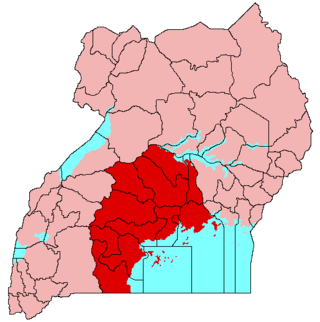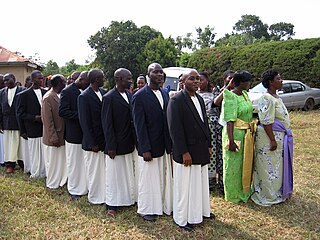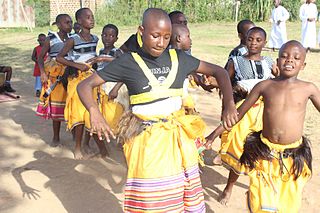
The Adhola people, also known as Jopadhola, are a Nilotic ethnic group of Luo peoples that live in Tororo District of Eastern Uganda and comprise about eight percent of the country's total population. They speak Dhopadhola,, which belongs to the Western Nilotic branch of the Nilotic language family. They are primarily pastoralists. The Jopadhola call their land Padhola which, according to historian Bethwell Ogot, is an elliptic form of "Pa Adhola" meaning the "place of Adhola", the founding father of the Jopadhola people. Officially, land of the Adhola is called Padhola, but the Baganda who misinterpret 'Widoma' – a Dhopadhola word for 'war cry' meaning 'You are in trouble' refer to the Jopadhola as "Badama". The social structure of the Jopadhola can be described as semi centralised because there is no traditional centralized government and its organization is limited to a clan called Nono. There are over 52 clans, each with cultural practices, common ancestry and a distinct lineage.

Buganda is a Bantu kingdom within Uganda. The kingdom of the Baganda people, Buganda is the largest of the traditional kingdoms in present-day East Africa, consisting of Uganda's Central Region, including the Ugandan capital Kampala. The 14 million Baganda make up the largest Ugandan region, representing approximately 16% of Uganda's population.

Sir Edward Frederick William David Walugembe Mutebi Luwangula Mutesa II was Kabaka, or king, of the Kingdom of Buganda in Uganda from 22 November 1939 until his death. He was the 35th Kabaka of Buganda and the first president of Uganda from 1962 to 1966, when he was overthrown by Milton Obote. The foreign press often referred to him as King Freddie, a name rarely used in Uganda. An ardent defender of Buganda's interests, especially its traditional autonomy, he often threatened to make the kingdom independent both before and after Uganda's independence to preserve it. These firm convictions also later led to conflicts with his erstwhile political ally Milton Obote, who would eventually overthrow him.

Culture of Uganda is made up of a diverse range of ethnic groups. Lake Kyoga forms the northern boundary for the Bantu-speaking people, who dominate much of East, Central, and Southern Africa. In Uganda, they include the Baganda and several other tribes

Kabaka is the title of the king of the Kingdom of Buganda. According to the traditions of the Baganda, they are ruled by two kings, one spiritual and the other secular.
Ssuuna II Kalema Kasinjo Mukaabya Sekkyungwa Muteesa Sewankambo Walugembe Mig'ekyaamye Lukeberwa Kyetutumula Magulunyondo Luwambya Omutanda Sseggwanga was Kabaka of the Kingdom of Buganda from 1832 until 1856. He was the twenty-ninth Kabaka of Buganda.

Ngoma are musical instruments used by certain Bantu populations of Africa. Ngoma is derived from the Kongo word for "drum". Different Bantu-inhabited regions have their own traditions of percussion, with different names for their instruments. In Kikongo, "ngoma" is used by extension to signify specific dances, social occasions, and rhythms. In Swahili, Ngoma music is used to describe music, dance, instruments including the drums, and events together as a joint cultural practice.

A kanzu is a white or cream coloured robe worn by men in the African Great Lakes region. It is referred to as a tunic in English, and as the Thawb in Arab countries. The kanzu is an ankle or floor length garment. It serves as the national costume of Tanzania as well as the Comoros, where it is called/pronounced 'Kandu' as well as thawb. The robe is also worn in some coastal Muslim regions of Tanzania and Kenya. The men of Uganda consider it their most important dress. Kanzu is a Ganda word of Swahili origin, which means "robe" or "tunic". In Tanzania, the term is used interchangeably with kaftan.

The Kasubi Tombs in Kampala, Uganda, is the site of the burial grounds for four kabakas and other members of the Baganda royal family. As a result, the site remains an important spiritual and political site for the Ganda people, as well as an important example of traditional architecture. It became a UNESCO World Heritage Site in December 2001, when it was described as "one of the most remarkable buildings using purely vegetal materials in the entire region of sub-Saharan Africa".

The Baganda also called Waganda, are a Bantu ethnic group native to Buganda, a subnational kingdom within Uganda. Traditionally composed of 52 clans, the Baganda are the largest people of the Bantu ethnic group in Uganda, comprising 16.5 percent of the population at the time of the 2014 census.
Uganda has a very long and, quite permissive, and sometimes violent history regarding the LGBT community, stretching back from the pre-colonial period, through British colonial control, and even after independence.

The Tooro people, also known as Batooro or Toro people are a Bantu ethnic group, native to the Tooro Kingdom, a subnational constitutional monarchy within Uganda.

Bigwala is a genre of ceremonial music and dance of the Busoga Kingdom in Uganda centered around gourd trumpets.

Annet Nandujja is a Ugandan traditional folk musician, composer and dancer. She sings in Luganda and performs with her group, The planets.

The Engalabi, also known as the Engoma ensajja, is a membranophone percussion instrument commonly used in Central Africa, particularly in Uganda. It is associated with tribes such as the Baganda, Banyankole, Buzimba, and Tagwenda. The instrument is also referred to by various other names, including omugalabi, engaija, egaabi, omugudu, omugwabe, long drum, Engaabe, and emiidiri.
Kadodi dance is a traditional dance performed by the Bamasaba people, also known as the Bagisu or the Gishu, who live in the eastern part of Uganda and the western part of Kenya. Kadodi dance is mainly associated with the Imbalu the male circumcision ceremony that marks the transition from boyhood to manhood among the Bamasaba. Kadodi dance is also performed at other occasions, such as weddings, festivals, and cultural events.

Edonga Dance, also known as Edonga, is a traditional cultural dance originating from the Karamajong people, an ethnic group of the Nilotic community residing in the northeastern region of Uganda especially in Kotido and Moroto districts. This dance form is performed by both men and women, accompanied by melodious songs sung in the native Karamojong language. Edonga Dance holds significant cultural importance within the community and heritage of the Karamajong people.

Amaggunju is a traditional folk dance of the Baganda, who represent the largest ethnic community in Uganda. This royal dance is performed during important occasions such as coronations, weddings, and other cultural events. Notable features of the dance are its distinct rhythmic drumming and energetic movements, executed by both male and female performers.

The Bahehe are an indigenous tribe that can be found in southeast Uganda, on Lake Victoria's northeastern shores, and on Uganda's border with Kenya. The Bahehe belong to the Bantu ethnic group that originated from Tanzania where they were part of the Hehe people who live in south-central Tanzania. According to the Uganda Bureau of Statistics (UBOS) census of 2014, the Bahehe community numbered 4,023.

Calabash is a traditional plant locally grown in many parts of Uganda. Its a non-food plant that produces several fruits of different sizes. The biological name of this plant is Lagenaria siceraria. Once harvested, its left to dry and is mainly used for traditional purpurses like dancing during traditional weddings, crafted as musical instruments by some tribes in their traditional dances for example the Bigwala, Baganda, Acholi, preserving milk, harvesting milk cream, and also used by traditional healers. Calabash is a symbolic cultural item that many Ugandan tribes use for different purposes.




















